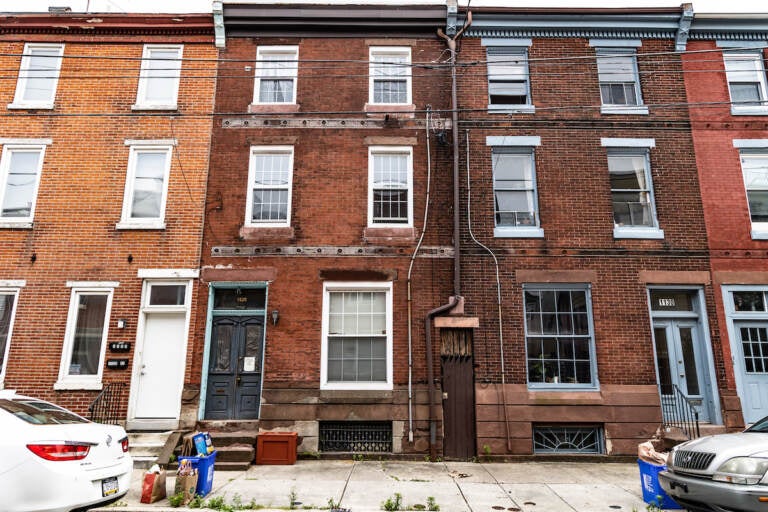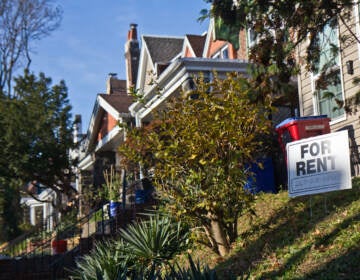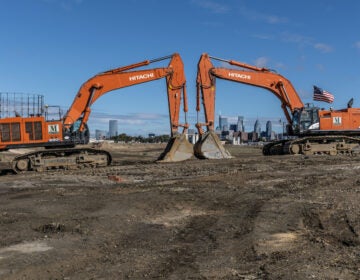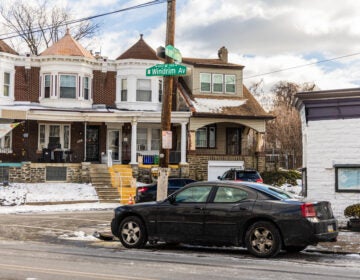Housing programs in Philly are rooted in regional incomes. Should that change?
For decades, AMI has shaped affordable housing programs in the city. Some advocates think the measure misses the mark and should be localized.

Rowhouses in Philadelphia’s Spring Garden neighborhood. (Kimberly Paynter/WHYY)
Have a question about Philly’s neighborhoods or the systems that shape them? PlanPhilly reporters want to hear from you! Ask us a question or send us a story idea you think we should cover.
In the world of affordable housing, area median income (AMI) is easily one of the most important metrics.
Defined as “the midpoint of a specific area’s income distribution,” AMI is a regional measure often used as a shorthand to signal the relative affordability of a particular housing initiative. More specifically, AMI is most often used to set income guidelines for government-backed housing and community development programs designed to help people with low incomes like the Housing Choice Voucher Program, the largest affordable housing program in the country. AMI benchmarks also are typically required for private developments built with the help of Low-Income Housing Tax Credits (LIHTC).
The AMI for a given region is calculated each year by the U.S. Department of Housing and Urban Development, and is largely based on median family incomes determined by the U.S. Census Bureau. The measurement reflects the incomes across a group of counties. That single figure is then applied to that entire area. There is no differentiation — even if incomes in some of those counties are much higher than in others.
Some housing advocates find that uniformity problematic, especially for poor cities like Philadelphia. They say the metric does not accurately reflect what families are really earning, meaning some housing programs may not be reaching the population they were designed to target.
Earlier this month, City Councilmember Jamie Gauthier introduced a resolution calling for a hearing to explore the shortcomings of using a regional AMI and how it “fails to reflect the true state of housing affordability needs of Philadelphians.”
The resolution also advocates for creating a localized AMI for the city, which continues to have the highest poverty rate among the country’s largest cities.
Here’s a look at what that would mean, and what proponents and opponents think of the idea:
What is Philly’s regional AMI?
Philadelphia’s AMI is based on incomes in 11 counties spanning four states.
In Pennsylvania, the metric is connected to Philadelphia, Bucks, Chester, Delaware and Montgomery Counties. In New Jersey, it includes Burlington, Camden, Gloucester and Salem Counties. The benchmark is also based on incomes in New Castle County in Delaware and Cecil County in Maryland.
In 2024, the regional AMI for a family of four is $114,400. The median household income for a similarly-sized family in Philly is about $87,000, according to HUD.
To Gauthier, that gap illustrates just how disconnected the regional figure is from what Philadelphians are actually earning. And she argues that’s hurting families in need of affordable housing, particularly deeply affordable housing, generally defined as 60% of AMI or lower.
“It just makes it really hard for I think the city and others in the public to determine whether we’re building genuinely affordable housing,” said Gauthier in an interview.
Researchers at the Reinvestment Fund reached a similar conclusion. A policy brief released in April found that using a localized AMI in Philadelphia could potentially make it easier for people with very low incomes to take advantage of affordable housing programs.
In 2023, for example, the rent limits for a LIHTC project with affordability set at 60% of the regional AMI ranged from $1,173 a month for an efficiency to $1,943 for a four-bedroom apartment, according to the brief. Based on HUD’s methodology, 60% of a localized AMI translates to rent limits from $878 to $1,454 a month.
Researchers found the limits rooted in a regional AMI would most greatly disadvantage Black and Hispanic residents in Philadelphia.
“When we did the analysis, what we realized, and what the data show, is that the AMI misstates in some sense the actual residents of the city of Philadelphia — all of us. Regardless of our race or ethnicity. But those who are white it misstates it by a little bit and those who are Black or Hispanic it misstates it by a lot because Black and Hispanic incomes are so much lower,” said Goldstein.
The result is that rental housing for families priced at a fraction of regional AMI will be far more affordable for white families than Black and Hispanic families in the city.
Asked about AMI, Kelvin Jeremiah, president of the Philadelphia Housing Authority (PHA), agreed that the regional metric has its drawbacks, but said PHA is serving the population it is required to serve. He noted that the average annual household income for the Housing Choice Voucher Program is approximately $20,000.
“From my perspective, what we need are more resources to expand the availability of affordable housing to meet the growing demand,” said Jeremiah.
PHA must adhere to federal income guidelines and could not implement a localized AMI.
What’s the argument against using a localized AMI?
Opponents of a localized AMI argue that such a metric would hurt families in need of what is known as workforce housing, a lesser-known tier of affordable housing for more middle-income residents. For example, certain residents who hold jobs in city government but still cannot afford a first home without help.
Mohamed “Mo” Rushdy, president of the Building Industry Association of Philadelphia, said abandoning the regional AMI would doom workforce housing programs like Turn the Key because developers would be unable to make those projects work without a substantial subsidy.
“You’re gonna kill that business completely,” said Rushdy. “The deals have to pencil out for the banks that are funding these jobs.”
There is also an issue of funding the switch.
If Philadelphia were to create and implement a localized AMI, the income thresholds and rent limits for qualifying households would be lower than they are right now. That means additional subsidies would be needed to cover the difference so these developments could continue operating as affordable housing, particularly while construction costs remain high.
For now, it’s unclear where that money would come from. Opponents argue it would be on the federal government to provide as Philadelphia, like most big cities across the country, is simply not in a financial position to cover the size of the gap.
Housing authorities, including Philadelphia’s, also have limited funding from the federal government to operate and add properties to their housing portfolios.
“You can’t just say, ‘I wanna change the program to these lower AMIs’ without you knowing how you’re gonna execute — without even talking to the people who are gonna execute,” said Rushdy.
Proponents of a localized AMI say the benefits of lowering rental limits for low-income families makes the challenge of finding additional resources worthwhile, especially given the number of Philadelphia households that are cost-burdened. That means more than a third of their income is used to pay for housing.
A report released in February by the Philadelphia Coalition for Affordable Communities found that 37% of all households were cost-burdened in 2022.
“We know that housing issues are not just housing issues. If we are unable to house people, that can become a mental health issue, that can become a carceral issue, that can sometimes become a public safety issue if people are pushed into spaces and communities that they are unfamiliar with,” said Gauthier.
“I think we have to be very transparent about what the needs of Philadelphians are and how that relates to how we’re using our housing resources,” she added.
What happens next?
A hearing on the issue is expected to take place sometime in November, said Gauthier.
The information gathered at that hearing may then be used as the basis for legislation to create a localized area median income.
It’s too early to say when a measure may be introduced.
Council’s last regular meeting this year is scheduled for Dec. 12.

Subscribe to PlanPhilly
WHYY is your source for fact-based, in-depth journalism and information. As a nonprofit organization, we rely on financial support from readers like you. Please give today.









